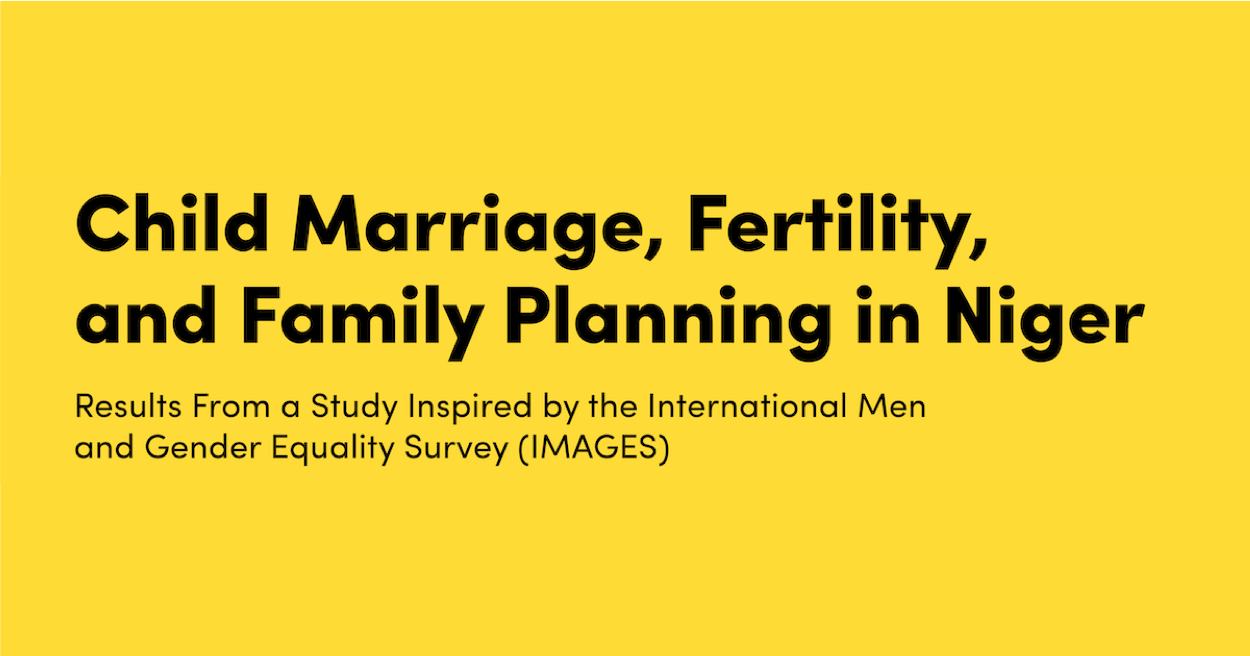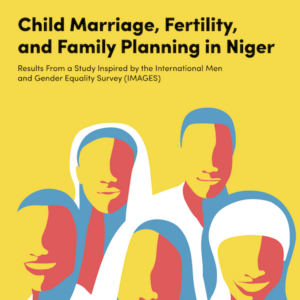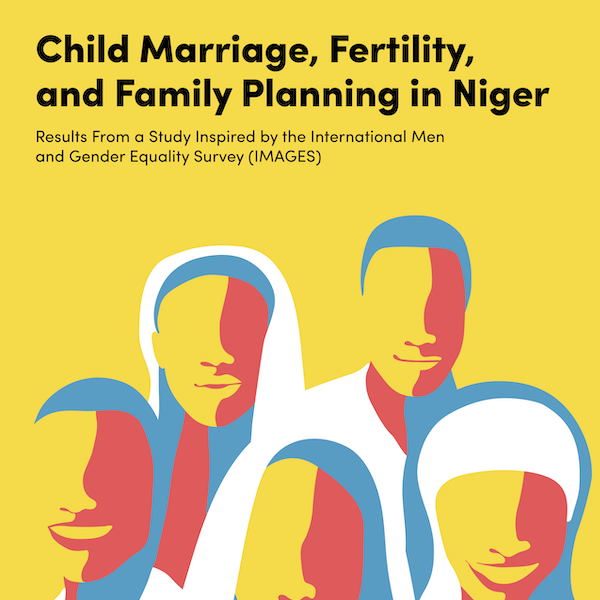
Results from research in Niger, inspired by the International Men and Gender Equality Survey (IMAGES), launch today. The quantitative and qualitative study provides new insights into child marriage, sexual and reproductive health and rights, and gendered transitions to adulthood in Niger.
Equimundo produced this study in collaboration with The OASIS Initiative, a project of University of California at Berkeley and Venture Strategies for Health and Development, and the Center on Gender Equity and Health at the University of California, San Diego.
Niger is known for having the highest rate of child marriage – a marriage or union in which at least one spouse is under 18 years old – and adolescent fertility in the world. Building on the growing evidence base about child marriage, this study offers critical insight into the motivations, attitudes, and behaviors of married adolescent girls and their husbands in Niger when it comes to their sexual and reproductive health (SRH) and relationships, providing findings, lessons, and recommendations for future policy and programming.
The two-part study, published in Child Marriage, Fertility, and Family Planning in Niger and Young Men’s Transition to Adulthood: Relationship Formation and Marriage in Maradi, Niger, gathered data from 2,400 married adolescent girls aged 13 to 19 and their husbands aged 15 to 53 in the Dosso and Maradi regions of Niger. The survey included questions on sexual and reproductive health; marital relations and parenting; healthcare access; gender attitudes and norms; and intimate partner violence. The qualitative, ethnographic research was conducted in rural villages to explore in greater depth the mechanisms behind marriage formation, expectations, and experienced realities among young men and women in Niger.
The study reveals the following key findings in Niger:
- Over half of the surveyed adolescent girls in the quantitative study were married during the early adolescent ages of 10 to 14.
- 29 percent of the husbands in the study were married between the ages of 12 and 19, pointing to the need for targeted programming for all adolescent age groups – boys as well as girls – to delay marriage initiation in Niger.
- The qualitative findings suggest that marital decision-making power in the Maradi region may be shifting away from parents as a result of men’s economic migration and increasing financial independence. As young men are becoming more financially autonomous from their parents, they have gained increased bargaining power in choosing whom and when they will marry – although parental opinion still appears to be considered in the marriage decision-making process. Despite this shift, strong social norms and expectations around fertility desires and age at first marriage appear unchanged: young men and community members shared perceptions that girls should be married by age 14.
- Adolescent wives consistently reported more inequitable attitudes and beliefs than their husbands did. 97 percent of adolescent wives, as compared to 82 percent of husbands, agreed that “a woman should never question her husband’s decisions even if she disagrees with them.” This is consistent with qualitative findings pointing to the importance of “obedience” as a marker of a woman’s marriage potential. The finding that adolescent wives may have more inequitable attitudes and beliefs may reflect their low levels of agency and reproductive empowerment relative to husbands, particularly given their younger ages and lower schooling background.
- Results confirm a strong desire for large families and starting these families early among both adolescent wives and their husbands. Childbearing may start early for both adolescent girls and boys in Niger; three in five adolescent wives already had a child at the time of the study, with a median age of 16 years at their last birth.
- About 10 percent of adolescent wives reported currently using a modern method of family planning. Despite strong support and social expectations for child spacing, the desire for children and religious/fatalistic motivations were key reasons for not wanting to use a family-planning method.
- Results show low awareness of modern family-planning methods as well as where to get them. Only half of the adolescent girls surveyed knew of a place where they could obtain family-planning methods.
- The results suggest a high prevalence of work-related stress and depression-related symptoms among husbands. Young men’s transitions to adulthood in Niger are profoundly influenced by the crisis in agriculture and the ensuing weakening and instability of rural household economies. Approximately 90 percent of husbands reported being frequently stressed about not having work or income, and about 70 percent reported feeling ashamed that their wife has to work.
- Husbands are more likely to participate in caring for children than in other household tasks, and husbands with better mental health outcomes are significantly more likely to participate in caregiving activities. Further, 93 percent of husbands interviewed wished to spend more time with their children.
- To the best of the authors’ knowledge, this study generated the first large-scale quantitative data on experiences of intimate partner violence (IPV) as reported by adolescent wives in the Dosso and Maradi regions of Niger. The results show only 12 percent of adolescent girls self-reporting experiences of IPV. However, a high percentage of husbands reported having witnessed or heard of male friends engaging in spousal physical violence. This gap may be due to certain questions around sexual violence having been perceived by adolescent wives as part of normal sexual and marital relations; under-reporting may have also been a contributing factor.
The findings suggest a number of potential opportunities to delay child marriage and to improve sexual and reproductive health outcomes for adolescent girls – and their families and communities – in Niger. Key recommendations include:
- Focus programming and policy efforts related to child marriage in order to target adolescent girls and potential husbands concurrently – and in gender-synchronized ways – during the premarital courtship period, while also engaging key reference groups and norms holders in the community.
- Work with boys and girls from an early age to challenge and transform harmful gender norms and related constructions of sexuality that contribute to child marriage through gender-transformative programming that effectively questions gendered power dynamics.
- Segment programming for and targeting of girls and boys in early adolescence (ages 10 to 14) given that half of participating girls in this study were married by 14 and that adolescence is a key time period during which to engage both girls and boys in light of their increasing opportunities to reflect on and reinforce or question inequitable gender norms.
- Invest in continuing adolescent girls’ education prior to and during marriage, as well as in related economic empowerment initiatives, while working with institutions and policymakers to enforce and promote continuing-education initiatives for adolescent girls.
- Target interventions to fathers of adolescent girls and boys, helping raise aspirations of fatherhood beyond men’s roles as providers and decision-makers, to promote their engagement as gender-equitable and nonviolent caregivers.
- Work with migrating young men – either pre- or post-migration – to delay marriage courtship and formation upon returning from labor migration, using this demographic transition to catalyze changes in attitudes and normative expectations around age at marriage, fertility, and family size.
- Increase resources on and investment in young men’s mental health issues and needs through the provision of psychosocial support for both adolescent girls and their husbands, particularly given the associations between mental health and other SRH outcomes.
- Given the general low awareness of family-planning services and methods, conduct targeted SRH and health-education activities community wide, among both adolescent girls and their husbands, to increase awareness and information about family-planning methods.
Access the full, quantitative report here: Child Marriage, Fertility, and Family Planning in Niger: Results From a Study Inspired by the International Men and Gender Equality Survey (IMAGES)
Access the qualitative report here: Young Men’s Transition to Adulthood: Relationship Formation and Marriage in Maradi, Niger

